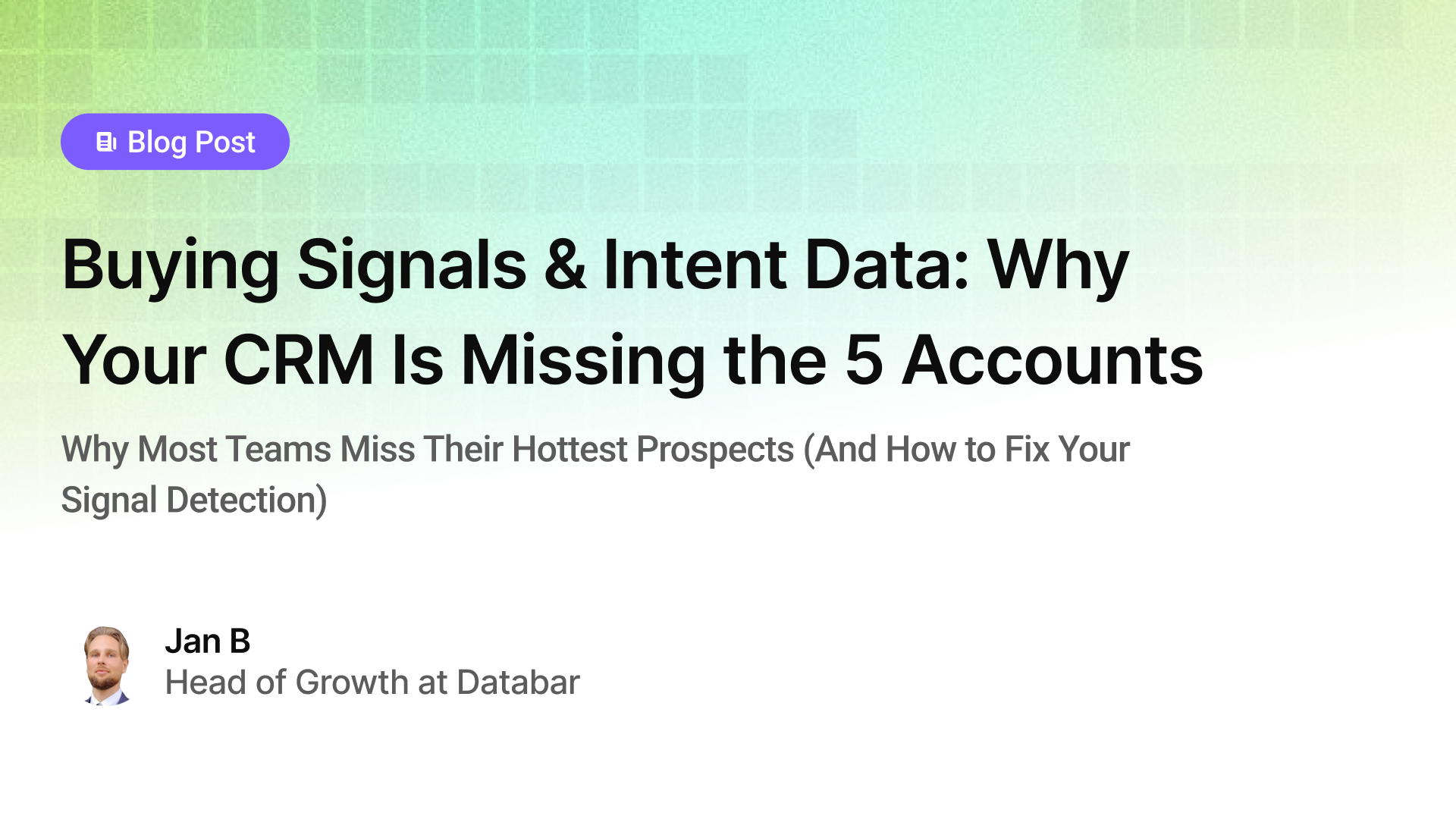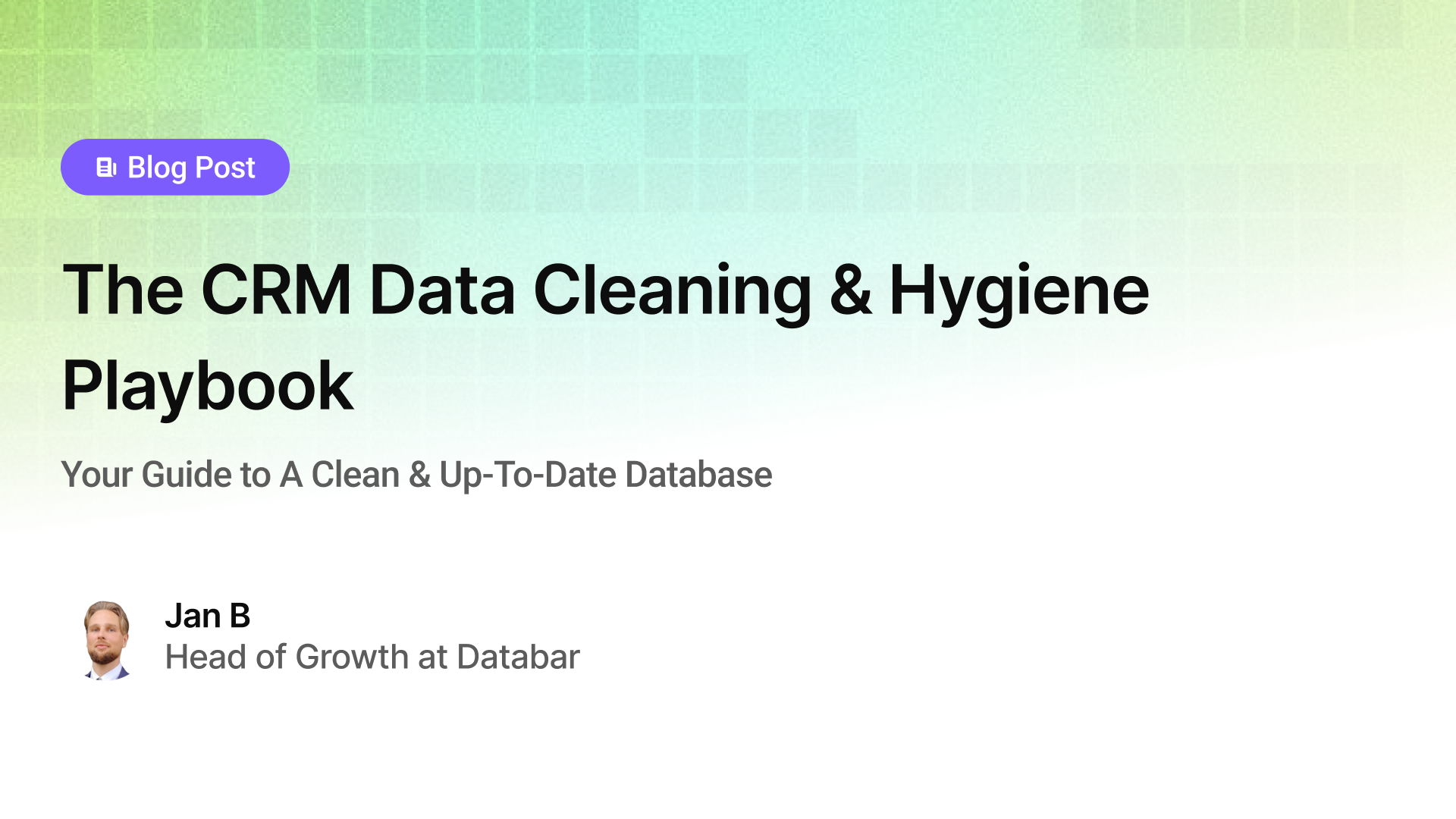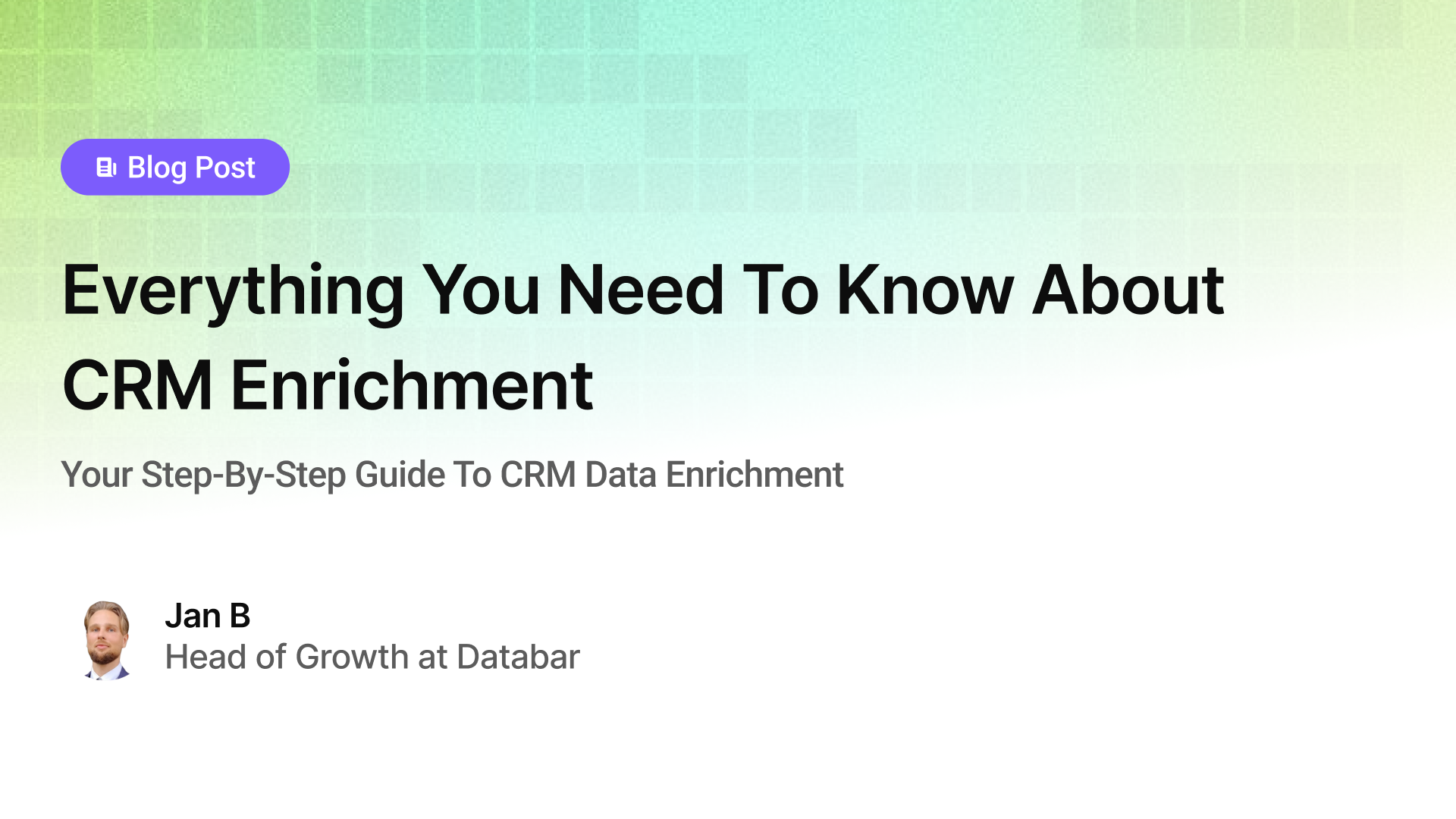Account-Based Data Enrichment: ABM Success Starts with Data
How Better Account Data Can Make Your ABM Work
Blogby JanJune 27, 2025

Your ABM program is only as strong as the data powering it. While 90% of B2B companies now run account-based marketing initiatives, only 17% achieve their full potential. The difference? Those winning companies understand that account-based data enrichment forms the foundation of every successful ABM strategy.
Think about your highest-value target accounts right now. Do you know which stakeholders influence purchasing decisions? Can you identify their current tech stack, growth signals, or buying intent? Without enriched account data, you're essentially running ABM blindfolded—personalizing campaigns based on assumptions rather than insights.
The stakes are significant. Companies with mature ABM programs report significantly higher revenue growth and see larger average deal sizes. But here's what separates the winners from the also-rans: they've mastered the art of account-based data enrichment to fuel hyper-personalized, multi-channel campaigns that convert.
This guide reveals exactly how to build an account-based data enrichment strategy that turns generic account lists into detailed intelligence dossiers, enabling the kind of personalization that turns target accounts into closed deals.
Why Traditional Data Approaches Fail for ABM
Most B2B companies still approach data collection like it's 2015—gathering basic firmographics and calling it a day. But account-based data enrichment demands a fundamentally different approach than traditional lead generation.
Consider the complexity of modern B2B purchases. The average enterprise deal involves 6-10 decision makers, each with unique priorities and pain points. Traditional data enrichment might tell you a company's size and industry. But can it reveal that the CFO just mentioned cost-cutting initiatives on an earnings call? Or that the VP of Engineering posted about modernizing their tech stack on LinkedIn?
ABM requires account intelligence, not just contact information. You need to understand the entire account ecosystem:
- Organizational structure and reporting relationships
- Technology stack and recent implementations
- Growth indicators and financial health
- Competitive landscape and market position
- Individual stakeholder priorities and initiatives
This depth of insight is essential. Research shows that 77% of B2B buyers expect vendors to understand their specific business needs before the first interaction. Miss that mark, and you've lost before you've even begun.
Account-Based Data Enrichment Framework
Successful account-based data enrichment follows a systematic approach that goes far beyond basic firmographics. Here's the framework that leading ABM practitioners use to build comprehensive account intelligence.
Layer 1: Foundational Account Data
Start with the bedrock—accurate, complete company information that forms the basis for all subsequent enrichment. This includes verified company details like legal entity names, all associated domains and subsidiaries, accurate industry classifications (not just high-level categories), and precise employee counts and revenue figures.
But foundational doesn't mean basic. Modern enrichment platforms can identify parent-child relationships, track M&A activity, and map organizational structures. For example, knowing that your target account recently acquired a company using your competitor's technology creates an immediate conversation starter.
Layer 2: Technographic Intelligence
Understanding an account's technology stack reveals both opportunities and obstacles. Technographic data shows you:
- Current solutions they're using (your competitors or complementary tools)
- Recent technology additions or removals
- Integration requirements and compatibility
- Technology spend indicators
- Digital maturity signals
This intelligence directly impacts your messaging. If an account just implemented Salesforce, positioning your solution's native SFDC integration becomes a key differentiator. If they're removing a competitor's tool, you've identified a prime opportunity.
Layer 3: Organizational Mapping
B2B purchases are team sports. Account-based data enrichment must map the entire buying committee, not just identify a single champion. This means discovering all relevant stakeholders and their roles, understanding reporting structures and influence patterns, tracking job changes and new hires, and identifying decision-making processes.
Advanced enrichment goes deeper, analyzing LinkedIn activity to understand individual priorities, tracking published content, and monitoring professional achievements and certifications. When you know the CMO just spoke at a conference about customer experience transformation, you can align your outreach accordingly.
Layer 4: Intent and Engagement Signals
Static data tells you what is. Intent data tells you what's happening right now. Modern account-based data enrichment captures real-time signals indicating buying readiness:
- Content consumption patterns on your website
- Engagement with competitor content
- Search behavior around relevant topics
- Participation in industry events
- Social media discussions about pain points
Companies showing high intent are significantly more likely to convert than those without buying signals. But intent data alone isn't enough—you need to contextualize it within the broader account intelligence to understand what it really means.
Layer 5: Contextual Business Intelligence
The final layer adds strategic context that turns data into actionable intelligence. This includes tracking funding rounds and financial events, monitoring strategic initiatives and public statements, analyzing competitive movements and market position, and understanding industry-specific challenges and regulations.
For instance, if your target account just announced a digital transformation initiative and you sell integration platforms, that's a compelling reason to reach out today rather than next quarter.
Building Your Data Enrichment Technology Stack
The complexity of account-based data enrichment demands sophisticated technology solutions. No single provider can deliver all the intelligence modern ABM requires. Here's how to build a comprehensive enrichment stack.
Multi-Provider Strategies Win
Relying on a single data provider is like fishing with one hook—you'll miss most of the opportunities. Leading ABM teams use waterfall enrichment approaches that query multiple providers sequentially. If Provider A lacks phone numbers for key stakeholders, the system automatically checks Providers B, C, and D.
This multi-provider approach typically delivers 2-3x better data coverage than single-source solutions. Waterfall enrichment tools automate this process, ensuring you get maximum data coverage without manual provider juggling.
The key is choosing providers with complementary strengths:
- Some excel at contact data accuracy
- Others specialize in technographics
- Certain providers focus on intent signals
- Specific solutions offer superior international coverage
Integration Architecture Matters
Your enrichment technology must seamlessly integrate with your existing ABM stack. Data silos kill ABM effectiveness. Modern architectures typically follow this pattern:
Data aggregation layer: Platforms like Databar that can access 90+ providers through a single interface, eliminating the need for multiple contracts and integrations.
Processing and normalization: Systems that clean, deduplicate, and standardize data from multiple sources into consistent formats your team can actually use.
Distribution and activation: Direct integrations with your CRM, marketing automation platform, sales engagement tools, and ABM orchestration systems.
Monitoring and updates: Continuous enrichment that keeps account data fresh, with alerts for significant changes like executive transitions or funding events.
Real-Time vs. Batch Processing
Not all enrichment needs happen in real-time. Smart ABM teams balance immediate needs with efficiency:
Real-time enrichment for high-value scenarios:
- Inbound form fills from target accounts
- Sales meeting preparation
- Triggered campaigns based on intent signals
Batch enrichment for scale operations:
- Quarterly account list updates
- Campaign planning and segmentation
- Territory and account scoring
Bulk enrichment capabilities let you process thousands of accounts efficiently, ensuring your entire target account list stays current without overwhelming your systems or budget.
Automation and Workflow Optimization
Manual enrichment doesn't scale. Modern account-based data enrichment requires sophisticated automation that maintains quality while processing hundreds or thousands of accounts.
Trigger-Based Enrichment Workflows
Instead of enriching everything immediately, smart ABM teams use triggers to optimize timing and costs:
New account creation: Automatically enrich when accounts enter your TAM or ICP Engagement signals: Deep enrichment when accounts show buying intent
Campaign inclusion: Enrich accounts before adding to targeted campaigns
Sales handoff: Fresh enrichment before SDR or AE outreach
Renewal approaching: Update account intelligence before renewal conversations
This approach ensures data freshness while managing enrichment costs effectively.
Multi-Channel Orchestration
Enriched data must flow seamlessly across all ABM channels:
Email campaigns pull in personalized data points like recent company news or technology changes
LinkedIn outreach leverages individual stakeholder interests and recent activity
Direct mail uses verified addresses and personalization elements
Digital advertising targets based on technographic and firmographic combinations
Sales conversations access complete account intelligence in real-time
The goal: consistent, personalized experiences across every touchpoint, powered by unified account intelligence.
Enrichment Quality Assurance
Automation without quality control leads to garbage in, garbage out. Implement systematic QA processes:
- Automated data validation rules catching obvious errors
- Sampling and manual review of enriched records
- Feedback loops from sales on data accuracy
- Regular audits comparing enriched data to known accounts
- Continuous provider performance monitoring
Leading teams maintain 95%+ data quality through systematic QA processes built into their automation workflows.
What’s Next For Account-Based Data Enrichment?
As we look toward 2025 and beyond, account-based data enrichment continues evolving rapidly. AI integration moves from experimental to essential, with platforms automatically synthesizing multiple data sources into actionable insights. Privacy regulations drive innovation in consent-based and first-party data strategies. Real-time enrichment becomes the standard, not the exception.
The companies winning with ABM understand this fundamental truth: data isn't just about information—it's about intelligence. The depth, quality, and timeliness of your account intelligence directly correlates with ABM success.
Those investing in sophisticated enrichment strategies see the results: higher response rates, faster sales cycles, larger deal sizes, and ultimately, significant revenue growth. The gap between data-rich and data-poor ABM programs will only widen.
Start Building Your ABM Data Foundation
Account-based data enrichment forms the foundation of every successful ABM program. Without rich, accurate, timely account intelligence, even the best ABM strategies fall flat. But with the right approach to enrichment—multi-layered data, automated workflows, privacy compliance, and continuous optimization—you can build the account intelligence that drives real revenue results.
The path forward is clear: invest in in-depth enrichment capabilities that go beyond basic firmographics. Build workflows that keep data fresh and actionable. Ensure seamless integration across your entire ABM tech stack. Measure impact relentlessly and optimize based on what drives revenue.
Ready to boost your ABM program with better data? See how Databar can enrich your target accounts using 90+ data providers in one unified platform, giving you the account intelligence that separates ABM winners from everyone else.
FAQs
Q: What's the difference between regular data enrichment and account-based data enrichment?
Account-based data enrichment goes beyond individual contact information to build comprehensive intelligence about entire organizations. While regular enrichment might add an email or phone number, account-based enrichment maps organizational structures, identifies all stakeholders in the buying committee, tracks company-wide initiatives, and monitors account-level buying signals. It treats the account as an ecosystem rather than a collection of individual leads.
Q: Which data types are most critical for ABM success?
The most impactful data types for ABM are technographic intelligence (understanding their tech stack), organizational mapping (identifying all decision makers), intent signals (knowing when they're ready to buy), and trigger events (tracking changes that create opportunities). While firmographics provide foundation, these advanced data types drive personalization and timing that make ABM campaigns successful.
Q: How often should account data be refreshed?
Data refresh frequency depends on the type and importance of accounts. Contact information should be updated every 90 days due to high turnover rates. Technographic data needs refreshing every 120 days as companies constantly adjust their tech stacks. Company fundamentals can be updated every 180 days. However, Tier 1 strategic accounts benefit from real-time monitoring and weekly updates to catch opportunities immediately.
Q: Can account-based data enrichment work for SMB-focused ABM programs?
Absolutely. While enterprise ABM gets more attention, SMB-focused programs benefit significantly from enrichment. The key is adjusting the approach: focus on automated enrichment rather than manual research, prioritize essential data types over comprehensive profiles, and use tiered strategies to manage costs. SMB ABM programs with proper enrichment see similar improvements in engagement and conversion rates as enterprise programs.
Related articles

Buying Signals & Intent Data: Why Your CRM Is Missing the 5 Accounts
Why Most Teams Miss Their Hottest Prospects (And How to Fix Your Signal Detection)
by Jan, October 06, 2025

Lead Scoring & Account Segmentation: Why Most CRMs Get This Backward (And How to Fix It)
How to build a system that tells your team who to call, when, and why
by Jan, October 06, 2025

The CRM Data Cleaning & Hygiene Playbook
Your Guide to A Clean & Up-To-Date Database
by Jan, October 04, 2025

Everything You Need To Know About CRM Enrichment
Your Step-By-Step Guide To CRM Data Enrichment
by Jan, October 03, 2025

